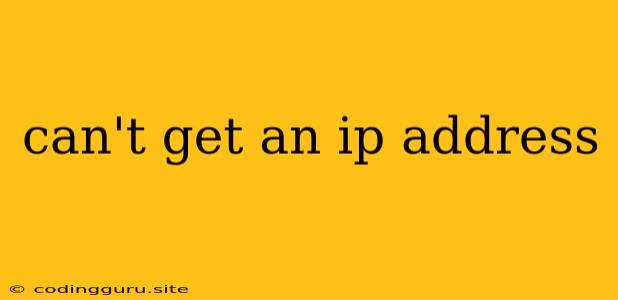Can't Get an IP Address: Troubleshooting Network Connectivity Issues
Facing the dreaded "can't get an IP address" error can be frustrating, leaving you stranded and unable to access the internet or network resources. This error often arises from network configuration issues, faulty hardware, or even simple misconfigurations. Don't panic! This article will equip you with the knowledge to troubleshoot and resolve this common network problem.
Understanding the Problem
An IP address acts as your device's unique identifier on a network. It's how devices communicate with each other. When you encounter the "can't get an IP address" error, it means your device isn't receiving a valid IP address from your network.
Common Causes
1. Incorrect Network Configuration:
-
DHCP Issues: Dynamic Host Configuration Protocol (DHCP) is responsible for automatically assigning IP addresses to devices on a network. If the DHCP server is malfunctioning or your device isn't properly configured to obtain an IP address from it, you'll encounter this error.
-
Static IP Conflicts: When you manually assign a static IP address, it's crucial to ensure that it doesn't conflict with another device on the network. If there's a duplicate IP address, neither device will function correctly.
2. Network Hardware Problems:
- Faulty Network Card (NIC): Your network card plays a vital role in establishing network connectivity. A defective network card can prevent your device from obtaining an IP address.
- Cable Issues: Damaged or loose Ethernet cables can interrupt network communication, leading to the "can't get an IP address" error.
- Router/Modem Problems: If your router or modem is malfunctioning, it might not be able to assign IP addresses correctly.
3. Firewall or Security Software Conflicts:
- Overly Restrictive Firewall: Some firewall configurations might block network connections necessary for obtaining an IP address.
- Antivirus Interference: Occasionally, antivirus software can interfere with network settings, causing the error.
Troubleshooting Steps
1. Check Basic Connectivity
- Physical Connections: Ensure all cables (Ethernet or Wi-Fi) are properly connected and secure.
- Network Device Power: Restart your modem and router to refresh their connections.
- Other Devices: Check if other devices on your network are experiencing the same issue.
2. Network Settings
- IP Configuration: Try obtaining an IP address automatically using DHCP. Go to your device's network settings and set the IP configuration to "Obtain IP address automatically."
- DNS Settings: Ensure your DNS server settings are correct.
- Wi-Fi Network: If using Wi-Fi, check your Wi-Fi password and ensure you're connected to the correct network.
3. Hardware Inspection
- Network Card: Try a different network card if available.
- Ethernet Cable: Replace your Ethernet cable with a known good one.
- Router/Modem: Restart or reset your router/modem. If the problem persists, consider contacting your internet service provider (ISP) for support.
4. Firewall and Security Software
- Temporary Disable: Temporarily disable your firewall or antivirus software to see if it resolves the issue.
- Firewall Rules: Check your firewall rules for any blocks on network connections.
5. Advanced Troubleshooting
- IP Address Reservation: Consider reserving a specific IP address for your device in your router's DHCP settings.
- Network Diagnostics: Use built-in network diagnostic tools or third-party network troubleshooting software to identify potential problems.
Example: Windows Troubleshooting
- Open Network and Sharing Center: Go to Control Panel > Network and Sharing Center.
- Change Adapter Settings: Click on Change adapter settings in the left-hand pane.
- Network Connection: Right-click on your active network connection (Wi-Fi or Ethernet) and select Properties.
- Internet Protocol Version 4 (TCP/IPv4): Double-click on Internet Protocol Version 4 (TCP/IPv4).
- Obtain IP Automatically: Select Obtain an IP address automatically and Obtain DNS server address automatically. Click OK.
- Restart: Restart your computer.
Example: Linux Troubleshooting
- Network Manager: Use the Network Manager graphical interface to connect to your network and obtain an IP address.
- Command Line: Open a terminal and run the following command:
sudo systemctl restart network-manager
- Check IP Address: Use the following command to verify if you have obtained an IP address:
ifconfig
Example: macOS Troubleshooting
- Network Preferences: Go to System Preferences > Network.
- Select Network Connection: Select your active network connection (Wi-Fi or Ethernet) in the list.
- Advanced Options: Click on Advanced....
- TCP/IP: Go to the TCP/IP tab.
- Configure IPv4: Select Using DHCP under Configure IPv4.
- Restart: Restart your computer.
Troubleshooting Tips
- Start Simple: Begin with the most basic steps and work your way up to more complex troubleshooting methods.
- Check for Updates: Ensure your operating system, drivers, and network devices are up to date.
- Document Your Steps: Keep track of the steps you've taken to troubleshoot the problem, which helps you retrace your steps or provide details if you seek assistance from others.
Conclusion
The "can't get an IP address" error can be a perplexing problem, but armed with the right knowledge and troubleshooting techniques, you can overcome it. By checking network configurations, examining hardware components, and verifying firewall settings, you can identify the root cause and restore network connectivity. Remember to start with basic troubleshooting steps and gradually move to more advanced techniques. If you're unable to resolve the issue, consult your ISP or a qualified network technician for assistance.
